|
‘La chose la plus importante dans la vie
sont les rencontres’
Hungarian Roots
Feri (Ferenc) Varga was born 1906 as one of ten children
into a wealthy family in what was then Hungarian village
Terézföld, now called Terezino Polje in Kroatia, just at
the border to Hungary. His father, Josef, was a
landowner and entrepreneur, mother Cecilia was from a
wealthy family from Vienna. His parents did not support
artistic ambitions, but his granduncle, Jozsef Kiss
(1843-1921) was one of the most distinguished Hungarian
poets of his time and his oldest brother Hugo also was
poet.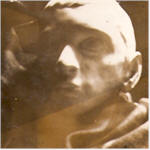 The wife of Hugo, Ida Moricz, an accomplished
sculptor and sister of Hungarian novelist Szigmond
Moricz, was an important early influence for Feri Varga.
She described her life in the book ‘Heten Voltunk’ (‘We
were seven’). The wife of Hugo, Ida Moricz, an accomplished
sculptor and sister of Hungarian novelist Szigmond
Moricz, was an important early influence for Feri Varga.
She described her life in the book ‘Heten Voltunk’ (‘We
were seven’).
The family moved to the Hungarian city of Pecs in 1910
and to Budapest in 1918, while the family fortunes
gradually eroded. Feri Varga had ambitions to become a
sculptor from early on and trained in
Budapest
with an Italian stone mason and with a self-taught
sculptor called Miklos Krivaci. In 1924 he won a price
from a Budapest newspaper for the portrait sculpture of
a woman that supported a six month stipend to study at
the ‘Ecole des Beaux-Arts’ in Paris.
Parisian Years
In the 1920s, Paris was a haven for thousands of
Hungarian ex-patriats, most of them fled the fascist
Horthy regime in Hungary. These Hungarians in Paris
created a tight-knit community with Hungarian language
newspapers, theaters etc.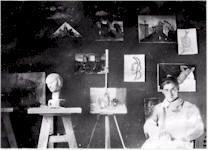 The regular meeting points and
centres of activities were the various cafes in Paris,
especially the Cafe Rotonde, later the Cafe Dome.
Eminent Hungarians in this scene were the artists Lajos
Tihanyi, Etienne Hajdu, and Arpad Szenes (who was
married to the artist Vieira de Silva), the
photographers Ervin Marton, Brassai and Kertesz.
Encouraged by this stimulating atmosphere, Feri Varga
decided to stay in Paris after his stipend ran out, and
he continued artistic studies at the ‘Arts-et-Metiers’.
There was an economic boom in Paris in those years, and
it was relatively easy to find work. The regular meeting points and
centres of activities were the various cafes in Paris,
especially the Cafe Rotonde, later the Cafe Dome.
Eminent Hungarians in this scene were the artists Lajos
Tihanyi, Etienne Hajdu, and Arpad Szenes (who was
married to the artist Vieira de Silva), the
photographers Ervin Marton, Brassai and Kertesz.
Encouraged by this stimulating atmosphere, Feri Varga
decided to stay in Paris after his stipend ran out, and
he continued artistic studies at the ‘Arts-et-Metiers’.
There was an economic boom in Paris in those years, and
it was relatively easy to find work.
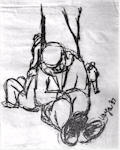 Feri Varga worked
first at a Citroen car plant, and later as a truck
driver delivering chocolate in order to support his
studies. The marriage to Josephine Kalmar, a Hungarian
Pianist of wealthy background, in 1929 allowed Feri
Varga for the first time to completely dedicate himself
to his own art. He switched to painting and drawing, and
became a regular caricaturist for the leftist journals
‘Monde’ and ‘L’Intransigeant’ in the 1930s. Especially
his connection to the ‘Monde’ (which was founded by the
communist writer Henri Barbusse) brought him into close
contact with many eminent intellectuals of his time,
such as writer and art historian Aragon, and film
composer Joseph Kosma (perhaps most famous for his song
‘Feuilles Mortes’ –Autumn leaves- to a text from Prevert).
The poet Jacques Prevert would become a friend of Feri
Varga with time. The writer and journalist Imre Gyomay
was another close friend of Feri Varga and wrote
articles about Varga, who in turn illustrated novels of
Imre Gyomay. These exhilarating times were finished as
soon as the Nazis occupied Paris. Feri Varga was forced
to flee Paris because of his association with the
leftist journal Monde’. Feri Varga worked
first at a Citroen car plant, and later as a truck
driver delivering chocolate in order to support his
studies. The marriage to Josephine Kalmar, a Hungarian
Pianist of wealthy background, in 1929 allowed Feri
Varga for the first time to completely dedicate himself
to his own art. He switched to painting and drawing, and
became a regular caricaturist for the leftist journals
‘Monde’ and ‘L’Intransigeant’ in the 1930s. Especially
his connection to the ‘Monde’ (which was founded by the
communist writer Henri Barbusse) brought him into close
contact with many eminent intellectuals of his time,
such as writer and art historian Aragon, and film
composer Joseph Kosma (perhaps most famous for his song
‘Feuilles Mortes’ –Autumn leaves- to a text from Prevert).
The poet Jacques Prevert would become a friend of Feri
Varga with time. The writer and journalist Imre Gyomay
was another close friend of Feri Varga and wrote
articles about Varga, who in turn illustrated novels of
Imre Gyomay. These exhilarating times were finished as
soon as the Nazis occupied Paris. Feri Varga was forced
to flee Paris because of his association with the
leftist journal Monde’.
Encounters on the Côte d’Azur
The flight from the Nazis led first to
Lyon
where Feri Varga stayed for one year and earned a living
as designer for silk garments.
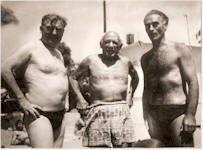 He finally moved to Cagnes Sur Mer at the Côte D’Azur where he would live in
a beautiful studio in Haute Cagnes from 1941 to 1961. By
now he was divorced from his first wife and remarried to
a Hungarian actress, Illa Veres Schreiber. The south of
France became something of a safe haven for many artists
and intellectuals that fled the Nazis and a tight-knit
community of like-minded developed in Cagnes and
surroundings. The neighbour of Varga was the author
Manes Sperber, whose home was meeting place to listen to
the BBC news in secret. He finally moved to Cagnes Sur Mer at the Côte D’Azur where he would live in
a beautiful studio in Haute Cagnes from 1941 to 1961. By
now he was divorced from his first wife and remarried to
a Hungarian actress, Illa Veres Schreiber. The south of
France became something of a safe haven for many artists
and intellectuals that fled the Nazis and a tight-knit
community of like-minded developed in Cagnes and
surroundings. The neighbour of Varga was the author
Manes Sperber, whose home was meeting place to listen to
the BBC news in secret.
The move to the sunny, colourful South would have a
dramatic impact on Varga’s art. This transition was also
fuelled by encounters with the many artists and writers
that made the South of France their home, including Marc
Chagall and Henri Matisse.
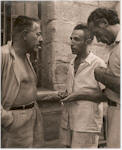 Through his close friend,
writer and poet André Verdet he got to know Pablo Picasso
in 1946. Through his close friend,
writer and poet André Verdet he got to know Pablo Picasso
in 1946.
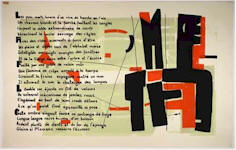 Picasso asked Feri Varga to organise an
exhibition in the ‘Musée Grimaldi’ (now ‘Musée
Picasso’), Antibes, together with Francoise Gilot. This
was followed by invitations to exhibit his work in solo
shows in the Musée Picasso, in the Gallery C. Allendy
and elsewhere. An important encounter was with Jean
Cocteau, also in 1954. Jean Cocteau asked Feri Varga
to illustrate or accompany 20 of his unpublished poems,
in a similar way as Varga did with Andrè Verdet before.
All poems are ‘Hommages’ (‘Hommage a Picasso’, ‘Hommage a
Kafka’, ‘Hommage a Rilke’ etc) and Varga wrote out and
accompanied each poem with a graphic using lithography. Picasso asked Feri Varga to organise an
exhibition in the ‘Musée Grimaldi’ (now ‘Musée
Picasso’), Antibes, together with Francoise Gilot. This
was followed by invitations to exhibit his work in solo
shows in the Musée Picasso, in the Gallery C. Allendy
and elsewhere. An important encounter was with Jean
Cocteau, also in 1954. Jean Cocteau asked Feri Varga
to illustrate or accompany 20 of his unpublished poems,
in a similar way as Varga did with Andrè Verdet before.
All poems are ‘Hommages’ (‘Hommage a Picasso’, ‘Hommage a
Kafka’, ‘Hommage a Rilke’ etc) and Varga wrote out and
accompanied each poem with a graphic using lithography.
 A limited edition was prepared in book form, each
page was countersigned by Cocteau and the work was
exhibited in 1955 in the Chateau Grimaldi in Cagnes. A limited edition was prepared in book form, each
page was countersigned by Cocteau and the work was
exhibited in 1955 in the Chateau Grimaldi in Cagnes.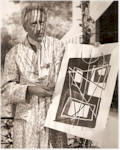 This exhibition became a turning point in Varga’s career
and he started to exhibit his work not only in France
(for example, the ‘Cercle Volney’), but also in Germany
(Folkwang Museum, Essen, Kölnischer Kunstverein) and
Sweden. In Cagnes he also met who would become his third
wife, the German Leonore Bässler. He married her in 1961
and moved with her to Neustadt/ Weinstrasse, a
provincial town in Southwest Germany, Palatinate, close
to Heidelberg and the French border.
This exhibition became a turning point in Varga’s career
and he started to exhibit his work not only in France
(for example, the ‘Cercle Volney’), but also in Germany
(Folkwang Museum, Essen, Kölnischer Kunstverein) and
Sweden. In Cagnes he also met who would become his third
wife, the German Leonore Bässler. He married her in 1961
and moved with her to Neustadt/ Weinstrasse, a
provincial town in Southwest Germany, Palatinate, close
to Heidelberg and the French border.
A new life and new art in Germany
The move to Germany proved initially hard on Varga’s
art, with the sudden isolation of a provincial town and
the change of light and life.
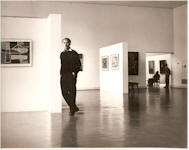 However, his visits to the
then virgin, almost jungle-like forests in eastern
Bavaria and the expose to scientific images through his
wife, a chemist and his father-in-law, a chemist and
biologist provided new inspirations that led to a change
in style. What inspired Varga were the tangles both of
the forest as well as the images from micrographs of
cells, fungi etc. He developed a unique technique using
hemp dyed with colour to create complex, multilayered
‘paintings’. In Germany he also started again to produce
sculptures in wood and metal. However, his visits to the
then virgin, almost jungle-like forests in eastern
Bavaria and the expose to scientific images through his
wife, a chemist and his father-in-law, a chemist and
biologist provided new inspirations that led to a change
in style. What inspired Varga were the tangles both of
the forest as well as the images from micrographs of
cells, fungi etc. He developed a unique technique using
hemp dyed with colour to create complex, multilayered
‘paintings’. In Germany he also started again to produce
sculptures in wood and metal.
The late works of Feri Varga are very original in that
even though they have a tachistic element, they reflect
Feri Varga’s appreciation of the aesthetics of the
natural world in its diverse dimensions, such as
microscopic or aerial photographs. He stated that his
art was not abstract, not non-figurative, rather his art
documents his response to nature.
Feri Varga died 1989, aged 83. He left behind his wife
and three children, one of which Paloma Varga-Weisz is a
respected artist on her own right. |